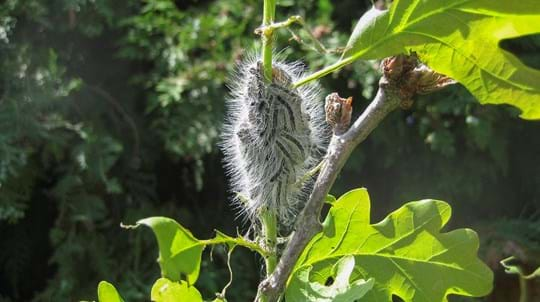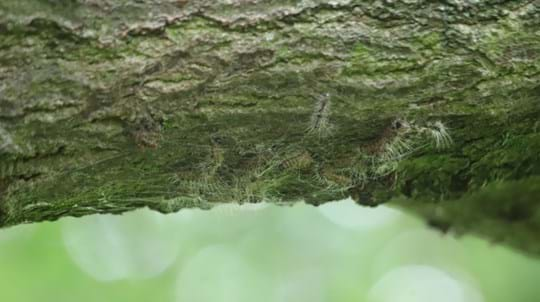Observatree volunteers help the Woodland Trust manage OPM

Conservation Evidence Officer - Woodland Trust
Oak Processionary Moth (OPM) caterpillars feed on oak leaves, causing defoliation. They move from their nest to feeding areas in processions, with the caterpillars forming a distinct line, and sometimes even multiple lines which move together.
Over the course of 2021, many of our invaluable citizen scientists have continued their surveillance of Woodland Trust sites for Oak Processionary Moth (OPM).
Alongside our usual surveys for Priority Pests and Diseases, this annual project focuses on the Woodland Trust estate and helps us in our assessment and management of OPM. The resulting data are also shared with colleagues from Forest Research thereby adding to the collective understanding of the nation-wide distribution of this pest.
Observatree volunteers battle OPM
This year an astonishing 24 Woodland Trust sites were surveyed by our volunteers… the highest number yet, 10 of those were by one volunteer, Stephen Middleton. We’d like to say a massive thank you to Stephen and to every one of our volunteers who commits their time to helping us manage this hazard to tree, animal and human health.
Throughout 2021 volunteers continued to survey Woodland Trust sites in and around London for any signs of OPM caterpillars, reporting back to estate staff who then arranged removal of the nests.
A volunteer’s view
"Heartwood is the best thing that has ever happened to St. Albans, and I love walking there. So, I was happy to take on the enormous task of walking all the paths to ensure that they were free of OPM and safe for everyone to enjoy. Whilst undertaking the survey I discovered paths I'd not visited before and walked over 20 miles. I did indeed get my first OPM sighting on a particularly busy path, so my efforts were worthwhile."
Amanda Yorwerth, Observatree Volunteer
“I enjoy having an excuse to visit woods and photograph other wildlife.”
Stephen Middleton, Observatree Volunteer
“I take part in the OPM surveys because I enjoy volunteering for a worthwhile cause. Not only that, but I also get to go to places I wouldn't ordinarily go to and exploring any wood is a delight in itself. I have attached a photo of a nest I found above a footpath in a wood called Gallows Grove.”
Roger Pope, Observatree Volunteer
A view from Woodland Trust Site Managers
“In central England we have two site managers covering Essex and Hertfordshire, respectively, which includes 16 sites requiring surveying every year for OPM. A number which continues to grow as OPM range expands. It would be extremely challenging for us to undertake this effectively within the narrow window when the caterpillars emerge and become visible. I couldn’t be more grateful to those people who give up their free time and considerable expertise to help us. It means projects can continue and Site Managers can keep doing what they do for woods, trees, people, and nature.”
Ian Froggatt, Estates Manager – The Woodland Trust
“Brilliant collaboration between our teams and the Observatree team of volunteers!”
Jenny Scholfield, Regional Director for the South-East
Winter is coming
Young caterpillars will emerge in spring. Discovering and dealing with caterpillars during the early stages of their life cycle is vital so preferred methods of treatment can be administered. Winter is therefore an extremely important time of year to be alert for any evidence of OPM egg masses, located on the branches. Unfortunately, these can be quite hard to see as they measure just 2-3cm in length.
Due to their sheer size, large oak trees can prove challenging to survey for signs of OPM and the winter season is a prime time to be on the lookout as the trees have lost their leaves. OPM caterpillars build silken nests during the summer before they emerge as adult moths. Spent nests can be easier to find during the winter months when they are not hidden by the leaf cover. It’s also important to check the foot of trees for any old nests which have fallen. Avoid touching any old nests as they are likely to contain shed caterpillar hairs that can irritate the skin.
Unfortunately, this invasive species can be found on all parts of the tree. Bearing in mind the number and sheer height of some oak trees, focusing on small oaks can be a much more practical way of surveying an oak population for OPM.
Please keep up the good work. Picking up any early warning signs of OPM is critical in the fight to protect our amazing treescapes.


